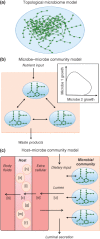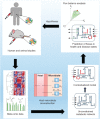Systems biology of host-microbe metabolomics
- PMID: 25929487
- PMCID: PMC5029777
- DOI: 10.1002/wsbm.1301
Systems biology of host-microbe metabolomics
Abstract
The human gut microbiota performs essential functions for host and well-being, but has also been linked to a variety of disease states, e.g., obesity and type 2 diabetes. The mammalian body fluid and tissue metabolomes are greatly influenced by the microbiota, with many health-relevant metabolites being considered 'mammalian-microbial co-metabolites'. To systematically investigate this complex host-microbial co-metabolism, a systems biology approach integrating high-throughput data and computational network models is required. Here, we review established top-down and bottom-up systems biology approaches that have successfully elucidated relationships between gut microbiota-derived metabolites and host health and disease. We focus particularly on the constraint-based modeling and analysis approach, which enables the prediction of mechanisms behind metabolic host-microbe interactions on the molecular level. We illustrate that constraint-based models are a useful tool for the contextualization of metabolomic measurements and can further our insight into host-microbe interactions, yielding, e.g., in potential novel drugs and biomarkers.
© 2015 The Authors. WIREs Systems Biology and Medicine published by Wiley Periodicals, Inc.
Figures



Similar articles
-
Metabolomics approaches for characterizing metabolic interactions between host and its commensal microbes.Electrophoresis. 2013 Oct;34(19):2787-98. doi: 10.1002/elps.201300017. Epub 2013 Aug 16. Electrophoresis. 2013. PMID: 23775228 Review.
-
Gut metabolome meets microbiome: A methodological perspective to understand the relationship between host and microbe.Methods. 2018 Oct 1;149:3-12. doi: 10.1016/j.ymeth.2018.04.029. Epub 2018 Apr 30. Methods. 2018. PMID: 29715508 Review.
-
Systems-level characterization of a host-microbe metabolic symbiosis in the mammalian gut.Gut Microbes. 2013 Jan-Feb;4(1):28-40. doi: 10.4161/gmic.22370. Epub 2012 Sep 28. Gut Microbes. 2013. PMID: 23022739 Free PMC article.
-
Metabolomic Modeling To Monitor Host Responsiveness to Gut Microbiota Manipulation in the BTBR(T+tf/j) Mouse.J Proteome Res. 2016 Apr 1;15(4):1143-50. doi: 10.1021/acs.jproteome.5b01025. Epub 2016 Mar 8. J Proteome Res. 2016. PMID: 26928523
-
Systematic prediction of health-relevant human-microbial co-metabolism through a computational framework.Gut Microbes. 2015;6(2):120-30. doi: 10.1080/19490976.2015.1023494. Gut Microbes. 2015. PMID: 25901891 Free PMC article.
Cited by
-
Untargeted metabolomic profiling identifies disease-specific signatures in food allergy and asthma.J Allergy Clin Immunol. 2020 Mar;145(3):897-906. doi: 10.1016/j.jaci.2019.10.014. Epub 2019 Oct 25. J Allergy Clin Immunol. 2020. PMID: 31669435 Free PMC article.
-
Gut Microbiota, Intestinal Morphometric Characteristics, and Gene Expression in Relation to the Growth Performance of Chickens.Animals (Basel). 2022 Dec 9;12(24):3474. doi: 10.3390/ani12243474. Animals (Basel). 2022. PMID: 36552394 Free PMC article.
-
Associations between the gut microbiome and metabolome in early life.BMC Microbiol. 2021 Aug 28;21(1):238. doi: 10.1186/s12866-021-02282-3. BMC Microbiol. 2021. PMID: 34454437 Free PMC article.
-
Engineering Useful Microbial Species for Pharmaceutical Applications.Microorganisms. 2025 Mar 5;13(3):599. doi: 10.3390/microorganisms13030599. Microorganisms. 2025. PMID: 40142492 Free PMC article. Review.
-
Challenges in the construction of knowledge bases for human microbiome-disease associations.Microbiome. 2019 Sep 5;7(1):129. doi: 10.1186/s40168-019-0742-2. Microbiome. 2019. PMID: 31488215 Free PMC article. Review.
References
Publication types
MeSH terms
LinkOut - more resources
Full Text Sources
Other Literature Sources

